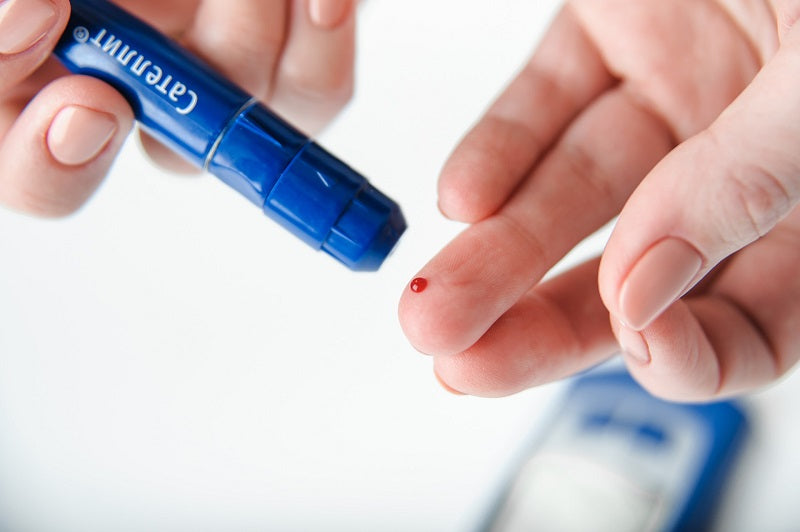Prevention is better than cure - a few words about type II diabetes
CONTENTS
- Insulin resistance – what characterizes it?
- Prediabetes – the final warning signal
- Type II diabetes – characteristics
- The most common causes of type II diabetes
- Other types of diabetes
- Can a proper diet protect us from type 2 diabetes?
- Summary
The increasing pace of life, stress, poor eating habits, and low physical activity are the factors that determine the incidence of lifestyle diseases. It is no coincidence that the percentage of cases of these diseases today is the highest in history. These include cardiovascular disease, cancer, depression, obesity, lung disease, and diabetes. We dedicate this article to the latter. As with all these diseases, it is also largely dependent on our lifestyle. Therefore, it is also worthwhile to understand the causes and ways to reduce the risk of disease.
Insulin resistance – what characterizes it?
Insulin resistance is usually the first warning sign that something is wrong in our body. This is a condition in which our pancreas is functioning properly and secreting the right amount of insulin. Unfortunately, proper function of this organ and the right amount of this hormone alone are not enough. It is also important that the cells themselves are sensitive to insulin. When we are dealing with insulin resistance, their sensitivity to this hormone is impaired and, to put it simply, much more of it is needed to trigger the appropriate tissue response. This means that the pancreas has to produce more and more of it. At this point, the cycle closes, because the increased amount of insulin makes the tissue increasingly resistant to it. This condition is very dangerous because it can lead to permanent damage to the pancreas and the subsequent development of type 2 diabetes.
Prediabetes – the final warning signal
Prediabetes is the final stage on the path to type 2 diabetes. Restoring proper body function is also important in this case. This refers to abnormal fasting blood sugar levels. While blood sugar levels may not yet indicate disease, they are far from ideal. The onset of this condition is determined by two parameters. The first is impaired fasting glucose levels between 100 and 126 mg/dL. Prediabetes can also be diagnosed with an oral glucose tolerance test. If our blood sugar level is between 140 and 199 mg/dL 120 minutes after administering this sugar solution, we have impaired glucose tolerance. Interestingly, this test doesn't always have to be negative in the early stages of the disease. Most often, it's because the fasting blood sugar level is abnormal.
Type II diabetes – characteristics
It is estimated that around 1,000 people worldwide suffer from all types of diabetes. 422 million people. And another 179 million are simply undiagnosed. In Poland alone, one in four people over 60 suffers from diabetes. Interestingly, the World Health Organization estimates that by 2030, diabetes will be the seventh leading cause of death worldwide. This type of diabetes is also called non-insulin-dependent because it depends mainly on our lifestyle rather than our genes. In addition, it is the most common form of this disease, accounting for almost 85% of all cases. Diagnosis is most often based on fasting blood sugar levels. If it is above 126 mg/dl, diabetes is present. In comparison, normal blood sugar levels are between 72 and 99 mg/dl. It is also worth remembering that the main cause of this disease is not a lack of insulin, but its incorrect effect on tissues. It's true that as the disease progresses, our pancreas gradually degenerates, and the amount of insulin it secretes decreases. However, this isn't the direct cause of the condition. It's also worth noting that diabetes is a very insidious disease. It can develop for years without any symptoms. This is evidenced, among other things, by the fact that it's very often diagnosed using other tests that aren't intended to detect it at all. This has given it the infamous status of a silent killer.
The most common causes of type II diabetes
Type 2 diabetes can be caused by many factors. However, it's usually not just one, but several at once. The most common causes of this disease include:
- Overweight, obesity, especially abdominal obesity
- the presence of diabetes in a close family
- Heart disease
- arteriosclerosis
- previous gestational diabetes
- too little physical activity
- sedentary lifestyle
- hypertension
- Birth of a baby weighing more than 4 kg
- chronic smoking
- Alcohol abuse
- high triglyceride levels in the blood
Other types of diabetes
Although type 2 diabetes is the most common form of this disease, it's worth knowing about the other variants. Interestingly, there are some that are caused by genetic factors, various other diseases, and lifestyle factors.
Insulin-dependent diabetes mellitus (IDDM) is a condition that affects approximately 15–20% of all people with the disease. Unfortunately, it cannot be prevented because it is a genetic disorder. It is most common in children and young adults. Cases of later-onset diabetes are known, but rare. Treatment involves insulin administration, as the pancreas does not produce any insulin in this case. An active lifestyle and a strict diabetic diet are also recommended.
Gestational diabetes – this type of disease affects pregnant women and almost always disappears after the birth of the baby. Typically, it affects about one in ten pregnant women. However, it's important to remember that women affected by it are more likely to develop type 2 diabetes in the future. In addition, gestational diabetes can cause a number of unpleasant symptoms, including blurred vision, drowsiness, polyuria, sudden hunger, and chronic fatigue. Immediate treatment is essential, as untreated complications can occur for both the mother and the child.
LADA diabetes – This is a form of type 1 diabetes, but is most commonly diagnosed after age 35. It has an autoimmune background and affects approximately 5-10% of all patients. Diagnosis requires the presence of typical type 1 antibodies—primarily anti-GAD.
Monogenic diabetes is one of the rarest forms of this disease. It affects approximately 1–2% of all patients. As the name suggests, it is caused by a single gene mutation. Therefore, genetic testing is the only way to diagnose it. In this case, we can distinguish between mitochondrial diabetes, MODY diabetes, and neonatal diabetes.
Secondary diabetes is also known as type III diabetes. Approximately 2-3% of all patients suffer from it. Its most characteristic feature is comorbidities, which very often determine its occurrence. It can be caused by certain medications, particularly those used to treat diseases of the cardiovascular system, but also of the urinary system. It can also be due to Cushing's syndrome, Cushing's disease, acromegaly, or various pancreatic diseases—including pancreatic cancer.
Can a proper diet protect us from type 2 diabetes?
The answer to these questions is, of course, "yes." Diabetes, as a diet-related disease, is strongly linked to our eating habits. The simplest way to put it is: such a diet should simply be healthy and balanced. All the principles of a healthy diet and avoiding overweight or obesity will work here. Follow a few simple guidelines to reduce your risk of disease.
Limit the consumption of simple sugars
Perhaps this is the most obvious point, but it's worth remembering that it's not just about limiting the consumption of commonly understood sweets. Yes, it will be most beneficial for our health, but you should be aware that this isn't everything. The main source of sugar in your diet should be products that contain as many complex carbohydrates as possible. It's worth choosing whole-grain bread, thick groats, brown rice, whole-wheat pasta, or those made from durum wheat. This causes simple sugars to be released into the blood gradually, thus avoiding glycemic fluctuations and large insulin secretions from the pancreas. It's also worth paying attention to the composition of individual store-bought products. Many of them contain simple sugars as specific thickeners. Remember that fruits also contain a lot of sugar. Let's treat them as a supplement and let vegetables become the basis of our diet. Let's add that fresh and uncooked foods have a much lower glycemic index than, for example, cooked ones. This doesn't mean you should completely change your diet overnight. However, it's worth striving to change your diet because it not only makes us healthier but can also protect us from future health problems.
Limit the consumption of animal fats
It has long been known that fat contains many more calories than carbohydrates and proteins. However, this does not change the fact that it is necessary for the proper functioning of our bodies. However, it is worthwhile to limit the consumption of these animal products and replace them with healthy fats of plant origin. This not only makes us healthier but also reduces the risk of diseases such as ischemic heart disease, atherosclerosis, obesity, and excessively high levels of triglycerides and LDL cholesterol in the blood. Avoiding these diseases is also very important in the context of diabetes prevention, as they increase the risk of developing the disease later in life. Therefore, we should also choose lean meats, sausages, fish, or low-fat dairy products. You should also limit the consumption of eggs, but not completely eliminate them. They are a source of highly digestible protein. We can also reduce meat consumption by including plant products such as beans, peas, chickpeas, and other legumes in our diet . This way, we get protein, as well as many vitamins and minerals. We should also pay attention to the methods of thermal processing of foods. Raw, steamed, or boiled in water, baked, or stewed products are best. It's no different with various spices. Choose fresh or dried. However, we should avoid ready-made spice mixes, as these usually contain large amounts of salt, which has a negative impact on our health.
Physical activity – why is it so important in preventing type 2 diabetes?
It's no secret that proper physical activity is the foundation for staying healthy for many years. It's also an important component of preventative measures to minimize the risk of developing type 2 diabetes. Physical exercise supports the functioning of virtually the entire body and, most importantly, allows us to maintain our body weight within the normal range and prevent obesity. It also strengthens our heart, lungs, and muscles, and allows us to reduce visceral fat. Also, remember that during physical activity, our muscles need energy. They require oxygen, but also glucose in the blood, thanks to which we somehow support our pancreas in its work. This brings many health benefits and significantly minimizes the risk of insulin resistance. Exercise can also affect our well-being. It effectively relieves stress and reduces the risk of depression.
Summary
It's always better to prevent the onset of various diseases than to deal with their treatment and the effects of the disease itself. The same applies to type 2 diabetes. Yes, we can never be 100% sure that we won't get it. However, keep in mind that preventative measures can significantly reduce this risk. In the vast majority of cases, however, it's a disease that depends on diet, lifestyle, and physical activity. So it's not worth overdoing your health when we can do so much in this direction.
THE PUBLISHER'S CHOICE
Dried plums 1 kg BIOGO
- €7,01
- €7,01
- Unit price
- / per
Dried White Mulberries 500 g ORGANIC
- €5,84
- €5,84
- Unit price
- / per
Almonds 1 kg BIOGO
- €11,69
- €11,69
- Unit price
- / per
Cranberries sweetened with apple juice organic 1 kg BIOGO
- €16,37
- €16,37
- Unit price
- / per
Dried dates 1 kg BIOGO
- €4,21
- €4,21
- Unit price
- / per
Unpeeled buckwheat groats 1 kg BIOGO
- €2,81
- €2,81
- Unit price
- / per
Walnuts 800 g BIOGO
- €8,65
- €8,65
- Unit price
- / per
Peeled sunflower seeds 1 kg BIOGO
- €3,04
- €3,04
- Unit price
- / per
PULLED ORGANIC SUNFLOWER SEEDS 1 KG BIOGO
- €4,44
- €4,44
- Unit price
- / per












































































































































